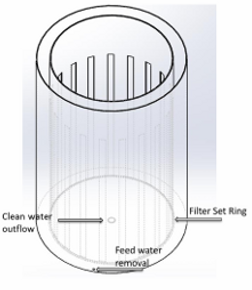Rural Osmosis Water Filter
-
Poor, low infrastructure communities dealing with mining runoff
-
Need: an affordable and effective water filtration system for a family of four
-
Solution: created osmosis filtration system that can supply a house with enough water every 24 hours
-
Results: $106 per unit osmosis water filter with 100+ gallon production per day

Osmosis Water Filter Project Scope
I was given the opportunity to address an issue in the world I felt strongly about and chose how to help communities whose water is affected by mining runoff using design and innovation.
The chemicals in the water from mining runoff range from arsenic to cyanide so I had to develop a filtration system that would eliminate or at the very least reduce the amount of those chemicals to a safe level.
I evaluated current technologies ranging from electrolysis to reverse osmosis to Chlorination, comparing the costs of each. Electrolysis was too expensive, reverse osmosis would have required a 120 ft pipe to obtain the pressure required to passively filter water and Chlorination would have created Chlorine Cyanide as a byproduct. Designing for rural or underserved communities, cost has to be feasible for actual implementation. The initial goal was to create one for sub $100. Another barrier would be the potential lack of electricity or infrastructure in those areas.
Therefore, I went with a novel osmosis filter design and to further reduce the cost I went with a design that could be fused to the bottom of a blue water barrel to prevent chemical concentration from building up within the filter itself, I added drain hole to the design to remove the water over time. This reduced the buildup of chemicals in the unfiltered water since osmosis filtering would only pull out a percentage of the chemicals due to the size of the molecules.
I also had to calculate the surface area needed for the filter based on its permeation rate of the membrane to supply enough water for a family of four within a 24-hour period or roughly 100 gallons. The end result was a filtration system that cost about $106 per unit and could also be sold as a do-it-yourself module to further reduce costs.